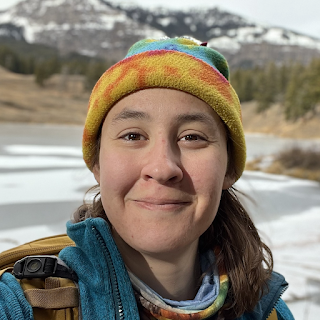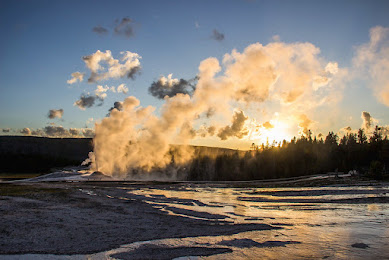by Lorena Salvado, San Marin High School
Geysers are one of the most fascinating geological phenomenons- with only a few 1000 on our planet, each requires specific conditions of magma streams, water, and geological networks to work. Most of today's geysers were formed 14,000 years ago- after the last glacial era of our planet. They operate under very intricate conditions-with lots of mystery around their exact workings, which is why Mara Reed became intrigued by them. Reed is a Ph.D. candidate at UC Berkeley's Department of Earth and Planetary Science, and she works at geyser sites - mainly in Yellowstone National Park- spending her days researching and collecting data. She came to Marin Science Seminar on Wednesday February 7th, 2024 and gave a talk about the current research concerning geysers as well as their importance. In this interview, she will share a few tidbits about her work and give some advice.
 |
| Mara Reed |
I enjoy hikes to the edge of Shoshone Geyser Basin in Yellowstone’s backcountry. If you hike in June or July, you’ll see incredible wildflowers along the way. It can be done as a long day hike (18 miles round trip) but most people choose to backpack. The trail passes by some interesting geyser formations. Just be sure to stay on the path, for your safety and the protection of the thermal features.
How much of your time is spent out in the field versus in the lab, which part do you like more?
I actually do my best to stay out of the lab! Most of my work involves spending just a couple weeks in the field every year, and then spending the rest of the time managing, analyzing, and writing about the field data. I find the lab work that relates to water chemistry or rock properties very “fiddly,” and would rather be outside.
How does geothermal energy collection affect geysers (In Iceland or other locations)?
There is almost always a negative effect, whether from large scale power production (like in Iceland and the US) or from smaller scale heating (like in New Zealand). Geysers need water and heat to operate, and geothermal wells can take both of those things away. The US once had a few geyser fields in Nevada, including significant ones at Beowawe and Steamboat Springs, but geyser activity declined and then ceased after geothermal power production started. I think geothermal energy is necessary if we want to get away from fossil fuel reliance but I do hope the world’s remaining geyser fields stay protected.
Do you think that knowledge of geysers on planet earth could affect our developments or research on other planets ( i.e. Mars or the Moon)?
We do find geyser-like features on other solar system bodies, including Enceladus (moon of Saturn) and Europa (moon of Jupiter), but we think they form and operate differently than geysers on Earth. I think hydrothermal areas and geysers are good laboratories to study how life lives and even thrives in extreme environments. We now know that there are microorganisms that live directly inside Old Faithful Geyser’s vent, which is pretty incredible. Understanding the present day life that exists in these environments can help us understand how life formed on our planet and where we might look for life elsewhere in the solar system.
How can the public help with geysers or geyser research?
We are very fortunate to have the world’s most concentrated geyser field in our backyard. The biggest thing people can do is to be a good steward of these areas. For visitors to Yellowstone, that means following the rules—keep to the trails and don’t mess with the geysers. It’s not just a safety thing. Geyser formations and bacteria mats are extremely delicate. Damage can be permanent. For anyone really interested in geysers and contributing to geyser monitoring, I would recommend reaching out to the Geyser Observation and Study Association (GOSA) for resources and tips on getting involved. Most geysers are still not monitored by scientific equipment, so visual observations of geyser activity are still a very important resource for scientists.
What's a piece of advice you would give to someone wanting to pursue a career in geyser research?
Since geyser science intersects with many different fields, it’s helpful to have a broad knowledge base. A solid foundation in physics, chemistry, and hydrogeology will serve you well. For those interested in pursuing scientific research in general, there are many opportunities at the college level. Some universities have strong undergraduate research programs (this is something to think about when choosing where to apply to college), but you can also apply for Research Experiences for Undergraduates (REU) programs where you can get paid to do research, usually over the summer at a certain university. Early exposure to research helps you figure out if you like doing it and what research questions interest you.
 |
| Lion Geyser picture by Mara Reed |
You can watch Mara Reed's Marin Science Seminar presentation here, "Getting a Grip on Geysers" with Mara Reed, Ph.D. candidate at UC Berkeley’s Department of Earth and Planetary Science
You can learn more about Mara Reed and her work here : https://www.marareed.com/
As well as check out her awesome photography here : photography
License for all photos used : license
And additional information used in this article can be found here , "USGS How do Geysers Work"




